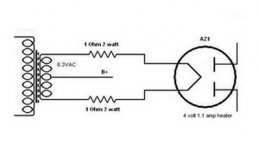I have been unable to find a 4 volt transformer for the filament on an AZ1 rectifier.Is it acceptable to simply use 6.3 volt supply with an appropriate dropping resistor on each side of the filament?Or maybe there is a better way?I seen a thread about this on a power tube,but figured a rectifier would be a different story.
Thanks
Thanks
NO !!!!
It's a HV rectifier and its filament must "float", fed from its own winding, High Voltage insulated fro everything else, specially ground.
Why do you want to use such an odd tube?
It's a HV rectifier and its filament must "float", fed from its own winding, High Voltage insulated fro everything else, specially ground.
Why do you want to use such an odd tube?
If you use a centertap on the 6.3V winding for the + then two 1 ohm (2W) on each side.With the + taken from one side a 2.2 ohm (5W) n the other side will do the tric.
But isn't the 6.3V winding on top? Perhaps you can make a 4V tap.
Mona
Yes,of corse,don't use the same 6.3V for the other tubes
But isn't the 6.3V winding on top? Perhaps you can make a 4V tap.
Mona
Yes,of corse,don't use the same 6.3V for the other tubes
Last edited:
Just something that I had laying around for some time and wanted to put it to use.It's a mesh plate and I thought it mght be nice on a phono stage.Enclosed is the circuit I had in mind.Seems like it would work,but if it is unacceptable,I might have to abandon it and go with a more common rectifier.Why do you want to use such an odd tube?
Attachments
There may be enough room between the windings and the E - I plate chassis to wind approximately 4 turns per volt and wind an additional 4volt supply.
Using 6.3vgolts with limiting resistors is not recommended and it must be an isolated winding!!!!!
Using 6.3vgolts with limiting resistors is not recommended and it must be an isolated winding!!!!!
Yes, the *main* point is that it needs its own *hundreds* of volts insulated filament winding.
Forget about connecting it to the same winding which heats other tubes.
Now, if the idea is coolness, *I* would rectify HV with 1N4007 or something, and connect this tube to 6,3V (attenuated with a fixed resistor to 4V) but NOT to rectify, just for its looks.
Sort of a *very* cool pilot lamp.
Long ago I did use a coke bottle sized WW2 vintage German tube, with *graphite* plates , with just the filament connected as a table night light.
It put out as much light (orange of course) as a kerosene wick lamp.
Forget about connecting it to the same winding which heats other tubes.
Now, if the idea is coolness, *I* would rectify HV with 1N4007 or something, and connect this tube to 6,3V (attenuated with a fixed resistor to 4V) but NOT to rectify, just for its looks.
Sort of a *very* cool pilot lamp.
Long ago I did use a coke bottle sized WW2 vintage German tube, with *graphite* plates , with just the filament connected as a table night light.
It put out as much light (orange of course) as a kerosene wick lamp.
As long as you use a separate 6.3V winding for the rectifier tube, the dropping resistor solution will work well.
Interwinding insulation capability will not be a problem with current production transformers, as long as you don't aim for a B+ in the kV range, which the AZ1 will not allow anyway.
Greetings,
Andreas
Interwinding insulation capability will not be a problem with current production transformers, as long as you don't aim for a B+ in the kV range, which the AZ1 will not allow anyway.
Greetings,
Andreas
- Status
- Not open for further replies.
- Home
- Amplifiers
- Tubes / Valves
- Looking for options for 4 volt heater
